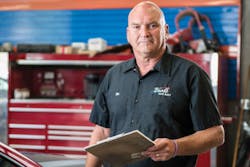For 10 days, Tim Beal was convinced he was going to die.
Beal, 35 years old at the time, had owned Beal’s Auto Body in Prescott, Ariz., for 13 years. For weeks, the driven shop owner had started to get headaches. He found it harder to read. He says his mind was “shutting down.” And his drive to work became more and more blurry until, one day, he had severe trouble reading road signs.
The culprit? A brain tumor putting pressure on Beal’s optical nerve, destroying his field of vision.
SHOP STATS
Beal’s Auto Body
Prescott, Ariz.
Size: 16,000 square feet
Staff: 16 (6 body techs, 2 estimators, 2 painters, 2 shop helpers, 1 customer service representative, 1 part-time receptionist, 1 bookkeeper, and 1 owner)
Monthly Car Count: 130
Annual Revenue: $3.2 million
“My wife had been a nurse for 12 years, and every patient she ever had with a brain tumor was dead in six months,” Beal says. “They threw dirt on them.”
In addition to the prospect of losing his life and his family was the realization that his successful business wasn’t set up to run without him … at all.
“Not only do I have to prepare my business because I'm going to be gone for this surgery, but also I'm not going to be here to run it,” Beal says he thought at the time. “What am I going to do? I have a wife and kids. I didn't plan for this.”
But Beal wasn’t going away forever. In fact, just six weeks after surgery, Beal was back in the shop. That’s because the brain tumor was a non-deadly, pituitary tumor, which simply required surgery and a few weeks away from work.
It was more than a relief; to this day, Beal refers to it as the “best thing that ever happened to me.”
The Backstory
Beal was a self-admitted hardhead for years. During his early 20s, he bounced from auto shop to auto shop, stringently independent, hard to work with, and motivated by an inflated ego. Beal wanted to micromanage everything and everyone.
Thus, for the first 13 years of Beal’s Auto Body’s existence, Beal did everything: the finances, the parts procurement, the insurance. He was working at least six 12-hour days each week, raking in $1.3 million per year in total sales with the same shop as today and slightly less employees. Beal, as he refers to it, was “making a killing” with his business.
“I was the typical, anal-retentive body shop owner,” Beal says. “It was my way or the highway, and I had to have a hand in every situation.”
But with success came a price. While his bank account was increasing, his personal life was slowly deteriorating. He rarely took vacation, relished in stress, and made little time for his family. If he had never believed his life was ending, Beal says his wife would have left him.
The Problem
EXPERT ADVICE — CONTINGENCY PLAN DOCUMENTATION
Bryan Stasch, vice president of the Automotive Training Institute, calls it the Brett Favre Syndrome. Brett Favre was known as an NFL quarterback. The minute he retires? He's just a former NFL quarterback.
“You have the same problem with shop owners,” Stasch says. “They've spent their whole lives building this business. That's who they are to their families, to their employees, to their neighborhood, to their community—to themselves.”
And because of it, owners often don’t consider properly setting up employees to run the business in their absence. Properly documenting an owner’s duties is, however, key, especially in emergencies.
I ask them to make a list of everything that they touch all day and every role they play. Once I have the list, I know what pieces need to be filled, and which pieces am I going to keep. Now I know what I have to write a process for, what I am going to delegate, who I am going to train on it, and how I am going to manage it. What does my process look like so that anybody and everybody knows where to go and how to do something?
Of course I'm going to think about my people. Identify who's my successor, who's in command while I'm gone. What's my mentoring process? What’s the organizational chart look like? Who’s responsible for who? Who reports to who? Do I have job descriptions to match?
Then there’s the sales and financial components, designing budgets and the bill paying schedule. Who’s handling the checkbook? What is all my critical banking information? Where's the bank? What are my account numbers? Who is my contact? Any details on a safe deposit box? Online banking sign-in information? Documented payroll information? What is the role between the owner/manager and the accountant?
The contacts for all my preferred vendors are key. Who we do business with? What products and services do we buy from them? What are the account log-ins and passwords for any of my accounts with these businesses?
We also cannot forget key performance indicators. Who's monitoring these to make sure the business still performs and grows? What does my marketing plan look like? Not just the current plan, but where is it going? What's the geographic and demographic and psychographic of my customers? What are my response rates and measurements of market? Who does the marketing pieces for me?
And because of his health issues, Beal was forced to ask himself: Who will run the shop when I’m gone?
The answer to that question? There wasn’t one—and that was the problem. He had a full staff of competent technicians and administrative workers, but, through no fault of their own, none of them could take over his job.
“I knew I'd hired good people,” Beal says. “Human beings in general want to do a good job and know how to do a good job. But I was a micromanager. Everything had to be done my way.”
As Beal would soon understand, job duties should have been reallocated to put less stress on him and make his shop more efficient. He had two employees on his administrative staff, but could have been offering more aid in the managerial duties he handled, such as DRP, parts procurement, payroll, etc.
When Beal first learned of his tumor, he realized that, because of his stubbornness, he was the only one actually fit to run his shop. So the news that Beal would miss work for six weeks created an interesting scenario: Beal didn’t need to set up a succession plan (although he certainly did soon after surgery), but instead prepare his staff to operate independently for a short period of time—and Beal had 30 days to do it.
The Solution
Completely new to the idea of working with others, Beal let his guard down and, for 30 days prior to his surgery, hired another employee for the front office and trained those three administrative workers to function without him.
So, each evening as the shop was closing down, Beal sat down with his staff and covered everything from communicating with the shop’s various DRPs to filling out payroll. This forced Beal to develop a list of standard operating procedures for each task, which he would tweak and define each day as he trained his employees. The SOPs were written out, including crucial details he’d never shared, like accessing banking accounts and passwords, and then reviewed each day as his employees carried out the tasks in front of him.
What Beal realized? Setting up a succession plan involves intense one-on-one training, transferring skill sets from one owner to a possible future owner. But a contingency plan involves a team, discovering people’s specific skill sets and how to best utilize them for a short period of time.
“Everywhere you work, you have a job,” Beal says. “And if somebody doesn't show up, you're not going to do your job and their job. Otherwise they wouldn't have the job to begin with. But if there's five of you, maybe you can come up with something a little more efficient and you can each pick up a little piece of that job and just do a little bit extra.
“The body shop industry is to the point to where they fear losing anybody. They don't know what they're going to do to replace them and how to train them once they come in. So, I decided to train everyone on everything.”
Next came the daily test runs. Slowly, Beal gave up his job responsibilities to his administrative employees until each one of them had a grasp on his daily managerial duties. One employee would handle DRP issues, but if the employee happened to be busy, Beal wanted to be sure the other employees had the ability to step in. Beal would watch over them and answer any questions they had about his processes.
Beal had communicated with his DRPs to let them know about hi
s scenario and established with whom they would communicate.
The day Beal left for surgery, his staff had performed enough test runs to function independently.
“When you really start digging into them, it's not long before you're handling every single car the exact same way—doesn't matter if its is customer-based or State Farm,” Beal says. “I was arrogant enough to think I was the only one that could handle it all. But, really, they picked it up so quickly and worked together so efficiently that it put me to shame.”
The Aftermath
Six weeks after surgery, Beal made his fateful trip back into the shop, expecting the worst.
“When I finally crawled back to my shop, payroll is being made, deposits are being made, customers are picking up cars, parts are being delivered,” Beal says. “I was expecting the building to be empty, because I thought I was the only guy in the world that could do this. Then I got back and everything was working and everybody had done a great job.”
Not only was his staff doing a great job—he says they were doing a better job.
“I knew I would have problems with all my insurers, because I had about six DRPs at that time and those were my personal babies and I took care of them and nobody else was allowed to,” Beal says. “So I called each one of them and told them I'd fix all the problems we'd had, and every one of them said the same thing: ‘We thought it ran better with you not there. Your people did a great job.’”
Through his contingency planning, Beal discovered there was a more efficient and less stressful way to run his business. To this day, his daily operations aren’t performed by a single, overworked shop owner, but instead distributed evenly amongst his administrative staff.
“Now I’m going to brag: We are so good, all of admin staff works four 10-hour shifts,” Beal says. “They do not have to be here five days a week because they are so in sync and can hand the files off. We've done such a great job over moving and handling things through.”
Beal is more committed than ever to his business, but the prospect of death made him appreciate life outside work. He now regularly takes vacations with his family, and even makes sure his staff is given plenty of time off. Because of it all, Beal says shop morale is at an all-time high.
“That's the biggest thing that most shops lack: Trust of one another,” Beal says. “You have all these individuals that are only worried about what their specific duty is. They don't care what somebody else has got to do. It's broken apart so much and it so dysfunctional, it's a nightmare.”
The Takeaway
These days, Beal preaches the lessons he learned, regularly coaching shops on setting up succession plans and increasing shop efficiency through his shop-training program, Cycle Time Solutions.
And, above all, Beal emphasizes his biggest takeaway from recognizing his own mortality: The difference between working in and working on a business.
“Before that illness, every day, I worked in my business,” Beal says. “After that illness, every day, I work on my business. And there's a huge difference when you just watch the business and work on the business and you're not caught up in performing every little task to make sure it doesn't collapse. That's really what the illness forced me to do. And I’m eternally blessed for that.”




